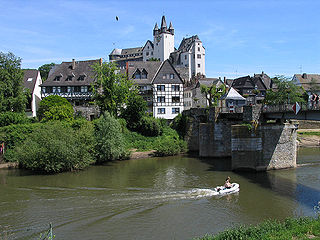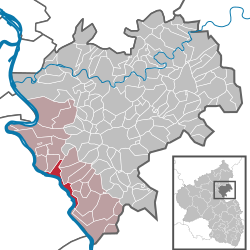Rhein-Lahn-Kreis is a district (Kreis) in the east of Rhineland-Palatinate, Germany. Neighboring districts are Westerwaldkreis, Limburg-Weilburg, Rheingau-Taunus, Mainz-Bingen, Rhein-Hunsrück, Mayen-Koblenz, and the district-free city Koblenz.

Katzenelnbogen is the name of a castle and small town in the district of Rhein-Lahn-Kreis in Rhineland-Palatinate, Germany. Katzenelnbogen is the seat of the Verbandsgemeinde Aar-Einrich.

The Rhine Gorge is a popular name for the Upper Middle Rhine Valley, a 65 km section of the Rhine between Koblenz and Rüdesheim in the states of Rhineland-Palatinate and Hesse in Germany. It was added to the UNESCO list of World Heritage Sites in June 2002 because of its beauty as a cultural landscape, its importance as a route of transport across Europe, and the unique adaptations of the buildings and terraces to the steep slopes of the gorge.

Sankt Goar is a town on the west bank of the Middle Rhine in the Rhein-Hunsrück-Kreis (district) in Rhineland-Palatinate, Germany. It belongs to the Verbandsgemeinde Hunsrück-Mittelrhein, whose seat is in Emmelshausen.
The Rheinsteig is a hiking trail following a mainly elevated path along the east bank of the Rhine River in Germany. Its 320 kilometres (200 mi) route stretches from Bonn to Wiesbaden, running parallel to the Rheinhöhenweg Trail and Rheinburgenweg Trail.

Diez an der Lahn is a town in Germany's Rhein-Lahn district in Rhineland-Palatinate, on the borders of Hesse. Diez is the administrative seat of the municipality of Diez.

Nassau is a town located in the German state of Rhineland-Palatinate. It lies on the lower course of the Lahn River, on the mouth of the Mühlbach, between Limburg an der Lahn and the spa town of Bad Ems, and is located in the Nassau Nature Park, surrounded by the Westerwald to the north and the Taunus to the south. The town is on the German-Dutch holiday road, the Orange Route. As of 2021, it had a population of 4,592.

Middle Rhine is the section of the Rhine between Bingen and Bonn in Germany. It flows through the Rhine Gorge, a formation created by erosion, which happened at about the same rate as an uplift in the region, leaving the river at about its original level, and the surrounding lands raised. This gorge is quite deep, about 130 metres (430 ft) from the top of the rocks down to the average water-line.

Kaub is a town in Germany, state Rhineland-Palatinate, district Rhein-Lahn-Kreis. It is part of the municipality (Verbandsgemeinde) Loreley. It is located on the right bank of the Rhine, approx. 50 km west from Wiesbaden. It is connected to Wiesbaden and Koblenz by railway. It has a Roman Catholic and an Evangelical church, and a statue of General Blücher. Historically, trade mainly consisted of the wines of the district.

Braubach is a municipality in the Rhein-Lahn-Kreis, in Rhineland-Palatinate, Germany. It is situated on the right bank of the Rhine, approx. 10 km southeast of Koblenz. Braubach has assorted medieval architecture intact, including portions of the town wall, half-timbered buildings, and castle Marksburg on the hill above.

Loreley is a Verbandsgemeinde in the Rhein-Lahn-Kreis, in Rhineland-Palatinate, Germany. It was historically part of the Duchy of Nassau, a sovereign state until 1866, and is currently located in the Nassau Nature Park. It is situated on the right bank of the Rhine, adjacent to the Nassau district and approx. 25 km southeast of Koblenz. Its seat is in Sankt Goarshausen. It was named after the Loreley Rock. On 1 July 2012, it merged with the former Verbandsgemeinde Braubach. Initially, the new Verbandsgemeinde was named "Braubach-Loreley", but it was renamed "Loreley" on 1 December 2012.

Nastätten is a municipality in the Rhein-Lahn-Kreis, in Rhineland-Palatinate, Germany. It is situated in the Taunus, approx. 25 km southeast of Koblenz, and 35 km northwest of Wiesbaden.

Maus Castle is a castle above the village of Wellmich in Rhineland-Palatinate, Germany. It lies on the east side of the Rhine, north of Katz Castle in Sankt Goarshausen and opposite Rheinfels Castle at Sankt Goar across the river.

Trechtingshausen is an Ortsgemeinde – a municipality belonging to a Verbandsgemeinde, a kind of collective municipality – in the Mainz-Bingen district in Rhineland-Palatinate, Germany.

Braunshorn is an Ortsgemeinde – a municipality belonging to a Verbandsgemeinde, a kind of collective municipality – in the Rhein-Hunsrück-Kreis (district) in Rhineland-Palatinate, Germany. It belongs to the Verbandsgemeinde of Kastellaun, whose seat is in the like-named town.

Urbar is an Ortsgemeinde – a municipality belonging to a Verbandsgemeinde, a kind of collective municipality – in the Rhein-Hunsrück-Kreis (district) in Rhineland-Palatinate, Germany. It belongs to the Verbandsgemeinde Hunsrück-Mittelrhein, whose seat is in Emmelshausen. From 1974 to 1999, Urbar was a Stadtteil of Oberwesel; however, with effect from 13 June 1999, it once more became a self-administering municipality.

Laurenburg is a municipality in the Rhein-Lahn district of Rhineland-Palatinate, in western Germany. The town, a health resort situated in the lower Lahn River valley, belongs to the Diez Municipal Association.

Rhine Castle trail - Rheinburgenweg, follows the left side of the Rhine from Bingen to Remagen-Rolandseck and the right side takes the route of the Rheinsteig from Rüdesheim am Rhein to Koblenz.

Rhein in Flammen is the name of five different firework displays along the river Rhine in Germany. The displays take place annually, at various locations along the river. On the five different dates, brightly illuminated ships sail the river in an evening convoy for their passengers to see the full firework display at each location of the river. The firework displays are started when the ships arrive. During the firework displays in St. Goar and St. Goarshausen, the convoy waits statically between the two castles Burg Maus and Burg Rheinfels. On the river banks wine festivals take place that attract hundreds of thousands of visitors every year.

Koblenz is an electoral constituency represented in the Bundestag. It elects one member via first-past-the-post voting. Under the current constituency numbering system, it is designated as constituency 198. It is located in northern Rhineland-Palatinate, comprising the city of Koblenz, the eastern part of the Mayen-Koblenz district, and the western part of the Rhein-Lahn-Kreis district.





































